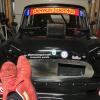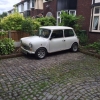I've worked in aerospace all my career and aircraft loom are all made straight but are combed to make them neat and suit the t-offs. If you use DR25 type heatshrink there is no going back when all shrunk down. What I did for my engine wiring was to use heatshrink sleeving as a wrap, by cutting down it and then wrap the loom as a tape. Secure the ends with a cable tie to hold in place. This gives more maintainability and is pretty robust and looks ok.
You can purchase heat shrink in rolls from Toolstation which is much chea per than pukka DR25.
Hope this helps.
Thanks for the info on aerospace, I've seen pictures of Airbus assembly with the loom all exposed & straight laid. With all the people I've spoken to there are distinct camps of those in favour of full seal vs those in favour of some kind of method to run new wires.
Hi Curley,
On my previous rally car I didn't do a full loom but did several part looms for adding various ancillaries - all done concentric twisted, self taught and what I will say, when you have done a loom and it has taken you ages (and it will, its hard work, especially with very long wiring runs with various wires t-ing off) you look at it and you'll think, wow that looks pretty smart - almost professional infact, then you'll put heat shrink over it or braiding and you'll never see it again.
This build I'm doing it differently - I'm paying some to do it, someone who does a lot of this sort of thing on some very high end rally cars and these were some of his thoughts: no point concentric twisting, the bundles of wires you are dealing with aren't really big enough to warrant it, the loom will still be fairly flexible and aslong as it is properly supported (he recommends 6") you wont be adding any stress either. not sure on the sleeving he was using but not heatshrink but he mentioned the ability to pull through a new wire if you have a fault on one (another reason not to twist - you'd never manage it). Bulkhead connectors, unecessary for my application (cant remember if you were going removable front or not) they would rarely get disconnected as I'm not going for removeable front end, but instead less bulky straight connectors behind the dash then through the bulkhead on grommets, still want connectors incase you take a front corner off you only need to replace that section without having to do a splice job.
Cant think of anything else at this moment in time.
Simon
Excellent info there Simon, I'll take your man at his word on the 6" lol. This was the nail on topic of concentric twisting as I'd been leaning towards it being overkill in this situation. One thing I'm not 100% on yet is the to seal or not to seal. I get the point that once it's sealed it can't be serviced. In all my years the only cabling faults (not electrical) have been due to environmental degradation and/or stress. Loose, soldered wires work harden, become brittle and break. Wires exposed to the element wick water etc. The agreement for suggest that a 'properly' sealed loom is immune to both of these.
I think I'm going to have my cake and eat it and try to do both. Given the use of bulkheads at the front I'm ok with having to remake the entire engine loom. Shoot, I'm ok with building two! But I'm also comfortable that DR25 in the cabin is overkill. I'll use over braid in the cabin.
With all that said I've spent today in the garage working on the rear of the car. I thought TMF might find interest in the process I'm following with my 'Clubman' loom.
Using Deutsch connectors one needs to first load a pin into the crimp tool. The correct crimp tools will come in from 4 sides and crush the solid pin onto the wire. We need to make sure there is a small insulation gap between the end of the pin and the wire. Once installed into the connector a service loom is added - just in case - and, because I'm using mostly white cable, coloured ID bands added.





Rinse & Repeat until all the wires are installed. It helps to align the service loops, ensure they all point inwards & some Kapton tape to secure. The Kapton tape also acts as a barrier and keeps the glue off when you seal the boots.



Before adding any heat shrink the cable are bound, or should I say laced, together to hold their shape. This allows the cables to be combed through as Kaj mentions. Only once the bundles are complete could I lay them onto the car and work out the transition. Oh and you need to be thinking ahead and threading your boots and labels on ahead of time. In the last photo I forgot to add one for the 4 pin and had to undo all the lace 


I've got more to do before I have to decide if I heat shrink or over braid the rest of the rear loom. I'm going to use DR25 for the rear lights as the cables pass in front of the fuel filler but everything under the parcel shelf is open.
Edited by Curley, 19 October 2019 - 08:06 PM.




























